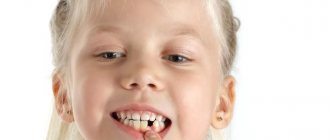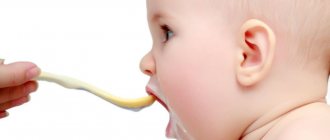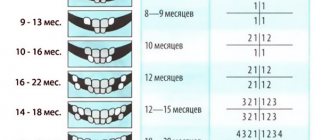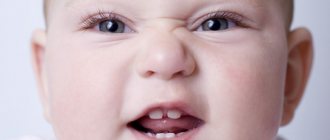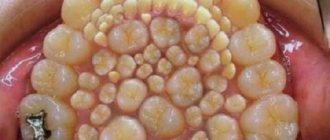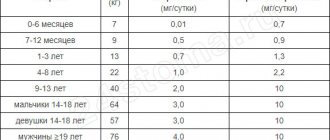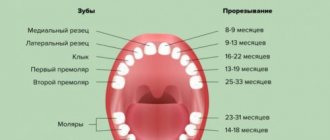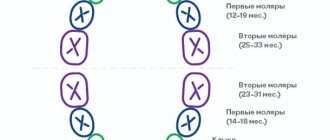From this article you will learn:
- when the first teeth appear
- sequence of teething in children,
- terms for baby and permanent teeth (scheme),
- reasons for delayed eruption.
Teething in children is the process of gradual appearance of tooth crowns above the surface of the gums. Teeth are considered fully erupted when their chewing surface begins to contact the antagonist teeth of the opposite jaw, and the gums cover the crowns of the teeth only in the area of their neck. Eruption always occurs in 2 stages. First, temporary milk teeth erupt, and only when the jaws reach the desired size do permanent teeth appear in place of the fallen milk teeth.
The eruption of primary teeth in a child usually begins at 5-6 months and will continue for up to 24-30 months, and during this time a total of 20 primary teeth will appear. The process of replacing baby teeth with permanent ones begins at the age of 6 years. The eruption of permanent teeth occurs up to 14 years of age inclusive - with the exception of wisdom teeth, which usually appear after 18 years of age. There is a strict sequence of teething in children, which you can see in the diagrams below.
Gums during teething: photo
Traditional symptoms of the eruption of baby teeth are swelling and redness of the gums, increased salivation and drooling, in addition, the child becomes restless and sleeps poorly. Sometimes indigestion and a slight increase in temperature may occur. In some cases, 2-3 weeks before eruption, a lump filled with clear or bluish liquid may appear on the gum, which does not indicate inflammation or any pathology (Fig. 2).
→ How to relieve teething symptoms in a child
Timing and order of teething in children -
The first teeth erupt in a child normally, starting from 5-6 months. The very first tooth (or rather a pair of teeth) that a child appears are the central incisors of the lower jaw. In some cases, this can happen several months earlier - including even in the first month of the child’s life. The reasons for premature teething have not yet been established, but it certainly negatively affects the health of baby teeth, contributing to their early carious lesions.
In this case, the development of the enamel structures of the tooth crown and their mineralization have not yet reached a certain degree - as a result, tooth enamel is more vulnerable to cariogenic microorganisms and the acids they secrete. Therefore, if your child has premature teething, then ideal oral hygiene is needed, as well as mandatory adherence to a number of recommendations on nutrition and feeding regimen. Ideally, a course of remineralization of teeth can be carried out, which will further increase their resistance to caries.
With normal development of the child, the timing of teething corresponds to what you can find in diagrams 1 and 2. A slight delay should not cause any alarm, however, a delay of 3-4 or more months - in some cases, may indicate a violation of the child’s physical development, metabolic disorders or the presence of a general somatic disease. Also, a delay in teething in children may be associated with the health of the mother and the influence of adverse factors on the fetus during pregnancy.
In what order do teeth appear?
Usually baby teeth erupt in pairs. If, for example, the left central incisor appears, then after some time the right one begins to grow. In what order this happens does not matter.
Research shows that sometimes the eruption of baby teeth in infants occurs with a delay of one to two months, which may be due to a genetic factor, the mother’s health during pregnancy, climatic conditions, etc.
If the delay is longer than the specified period, we recommend showing the baby to a specialist.
We recommend that your child's first visit to the dentist be between the ages of six months and nine months. At the appointment, a specialist will conduct an examination and give recommendations on oral hygiene: which toothpastes and brushes are best to use, how to brush your teeth correctly.
Diagram of teething of primary occlusion
A newborn child has 20 primary tooth buds inside the upper and lower jaws (10 follicles for each jaw). The timing of teething in children, according to different authors, can vary greatly, and in diagram No. 1 below you can see generally accepted figures from the “National Guide to Pediatric Dentistry”. In this diagram you can see the timing of the eruption of baby teeth in completely healthy children who do not have any pathology.
Scheme of teething in children without pathology (scheme No. 1) –
According to statistics, the normal schedule for teething in children is observed only in 42% of cases. A delay in the timing of eruption is observed in approximately 48% of children, which is associated with illnesses suffered - both by the mother during pregnancy and by the newborn child (you can read about the main reasons for the delay in eruption below). Approximately 10% of all children experience early eruption of primary teeth, and in a small percentage of cases this can occur even during fetal development.
What may cause delayed teething?
Many factors can influence the delay in the eruption of primary teeth. For example, in premature children with general somatic pathology, the eruption of the first teeth in 61% of cases occurs only at the age of 8 months and older. Moreover, if a premature baby has suffered an intracranial birth injury or a severe infectious-inflammatory disease, then eruption may begin even later - at 11-12 months and older.
The timing of the onset of teething also depends on the duration of natural feeding. In bottle-fed children, in 60% of cases, the first temporary teeth erupt only at 8 months or later. In mixed-fed children, delayed eruption was observed in only 30% of cases. A lot depends on the state of health of the mother during pregnancy, as well as on the course of pregnancy. For example, when examining children under 3 years of age whose mothers suffered severe toxicosis, it was found that the start of the eruption of primary teeth in them shifted to 8-10 months.
It is also worth noting that delayed eruption in a small percentage of cases can occur even in completely healthy children, which is associated with a genetic factor (for example, when late eruption was observed in one of the child’s parents). The “National Guide to Pediatric Dentistry” published a table that clearly shows what the delay in eruption may be if a child has various diseases.
Table No. 1 - timing of the onset of eruption in the presence of pathology
List of reasons for delayed eruption of baby teeth:
1) The first group of reasons includes diseases of a woman during pregnancy, as well as features of the course of pregnancy. Moreover, it is worth noting that all these reasons have only a moderate effect (unlike diseases in the 1st year of a child’s life). These reasons include:
- toxicosis of the 2nd half of pregnancy,
- kidney disease,
- previous pneumonia or acute respiratory infection with high fever,
- herpes infection, rubella, toxoplasmosis,
- constant chronic or short-term severe stress.
2) The greatest influence on the delay in the eruption of primary teeth is caused by diseases suffered during the 1st year of the child’s life:
- neonatal sepsis,
- pneumonia, frequent acute respiratory infections,
- atopic dermatitis, rickets,
- general somatic pathology,
- convulsive states,
- intestinal toxicosis,
- prematurity and postmaturity,
- hypothyroidism (lack of iodine intake),
- poor unbalanced diet,
- for epilepsy.
Causes of early teething: studies have found that early teething is most often characteristic of children born with a large body weight. Moreover, there is a clear correlation - the greater the child’s body weight, the earlier the eruption of temporary teeth begins. Also, premature eruption is observed with adrenal tumors accompanied by hyperfunction (24stoma.ru).
Violation of the sequence of teething in children -
Physiological teething is characterized not only by timing, but also by such characteristics as pairing and sequence. Those. all teeth should erupt in pairs, for example, first 2 central incisors of the lower jaw erupt at once, then 2 central incisors of the upper jaw, etc. See diagram No. 1 above for the timing and sequence of baby teeth eruption. In healthy children, there are usually no violations of pairing and sequence during teething.
But in children who have suffered from rickets, sequence violations occur in approximately 52% of all cases, pairing disorders occur in approximately 35% of cases. In children with rickets, the eruption of primary teeth very often begins with the central and lateral incisors of the upper jaw, and when the crowns of the teeth erupt approximately halfway, the eruption process may stop for many months. The latter is associated with a violation of the formation of the roots of milk teeth, because when milk teeth just begin to erupt, their roots are still only 25-50% formed.
Norms for the number of teeth before and after one year
The first milk teeth normally appear in newborns up to one year old - at 6 or 8 months, with rare exceptions at 3-4 or closer to 12. The order of their appearance in the mouth is usually the same for all babies, but the timing is determined by nature.
According to the average pattern for all babies, the incisors appear in the following sequence up to one year:
- at 6–10 months - two lower central teeth;
- at 8–12 months - two upper central incisors;
- Between 9 and 16 months, the upper and lower lateral teeth emerge sequentially.
Thus, by one year the baby becomes the proud owner of eight incisors. Although the normal number of baby teeth in a 1-year-old child is not established on a single scale.
After the first birthday, teeth grow more actively. The cutting table looks like this:
- by 13–19 months - molars from above;
- by 14–18 - molars from below;
- by 2 years - upper and lower canines;
- at 2.5–3 years - the second set of molars above and below.
A full-fledged jaw from baby teeth will be formed by 30 months, the child will have twenty teeth in his mouth. They will change to native ones closer to first grade.
Parents do not need to remember the rules. There is an interesting formula for counting teeth by baby's age. There should be four less than the months of the baby’s life.
For example, a girl is 10 months old, subtract 4 from her age and get the result: after 10 months there should be 6 teeth in her mouth. Do not forget that the figure will be average, and the amount in a certain period depends on the individual characteristics of the newborn’s development and heredity.
Period of eruption of permanent teeth -
The eruption of permanent teeth has a number of features, because... This process occurs simultaneously with the resorption of roots and loss of baby teeth. The rudiments of permanent teeth are located only 1-2 mm from the roots of milk teeth, and when a permanent tooth begins to erupt, it puts pressure on the roots of the milk tooth located above it, which leads to their resorption. Accordingly, baby teeth gradually lose contact with bone tissue, and their crowns become mobile.
And only the eruption of molars (large lateral chewing teeth) occurs without the loss of milk teeth, which is associated with a smaller number of the latter. By the way, in girls, the loss of baby teeth, as well as the beginning of the eruption of permanent teeth, occurs 4-7 months earlier than in boys, which is associated with hormonal levels. You can see the sequence and timing of the eruption of permanent teeth in children in diagram No. 2, which clearly shows the time ranges for the start of eruption for each permanent tooth.
Permanent teeth in children: order of eruption
The first permanent teeth to erupt are the first molars, which usually occurs at 6 years of age. True, recently, teething increasingly begins at the age of 5, and this is associated with the acceleration of the physical development of children. The process of eruption of permanent teeth ends by the age of 14 (with the exception of wisdom teeth). Teeth are considered fully erupted only when their chewing surface begins to contact the antagonist teeth of the opposite jaw, and the gums cover the crowns of the teeth only in the area of their neck.
Moreover, please note that the sequence of eruption of permanent teeth on the lower jaw differs from the sequence of eruption of teeth of the same name on the upper jaw. For example, in the lower jaw, the first molars and central incisors erupt simultaneously, while in the upper jaw, the first molars appear earlier. Moreover, absolutely all teeth (with the exception of premolars) erupt earlier in the lower jaw.
Beginning of replacement of baby teeth with permanent teeth (6 years) –
Signs of teething
The appearance of the first milk teeth is a normal physiological process, and, according to dentists, it should not be accompanied by any pathological symptoms. Stomach upset, cramps, and vomiting during this period usually occur against the background of acute respiratory viral infections or existing chronic diseases.
General signs of the onset of growth of primary teeth:
- redness and swelling of the gums,
- itching of the gums, due to which the baby puts toys and any hard objects into his mouth,
- a small hematoma may appear at the site of the future tooth,
- excessive drooling and, as a result, irritation and rash on the chin and around the mouth,
- poor appetite
- slight increase in temperature,
- tearfulness, sleep disturbance.
The fact that the replacement of baby teeth with permanent ones will soon begin is indicated by an increase in the distance between the teeth. In general, the symptoms of the eruption of molars and primary teeth are similar: the child may be capricious, eat poorly, and his gums may become slightly swollen and red. If severe pain occurs, you should consult your pediatric dentist.
Causes of delayed eruption of permanent teeth –
If for baby teeth delayed eruption is considered to be a delay of only 2-3 months, then for permanent teeth this figure is already 2-4 years. Among the main reasons for the delay in the eruption of permanent teeth, it is particularly worth highlighting the preceding inflammatory processes in the area of the roots of primary teeth, as well as the early removal of primary molars.
1) Violation of local conditions for teething:
- underdevelopment of the upper and lower jaws,
- lack of space in the dentition,
- premature removal of primary molars,
- incorrect position of the tooth germ,
- tooth germ injury,
- inflammation in the bone tissue of the jaws, for example, with purulent periodontitis of baby teeth.
2) Common causes of delayed eruption of permanent teeth:
- rickets or congenital syphilis,
- exudative diathesis,
- various chronic intoxications,
- metabolic disorders,
- disturbances of reflex-trophic processes,
- hormonal imbalances (for example, hypothyroidism, hypofunction of the thymus or adrenal glands).
Which permanent teeth are more likely to experience delayed eruption?
- one of the canines of the upper jaw (MF) – occurs in 43.64% of children,
- two HF fangs at once – in 25.65%,
- second premolar of the mandible (MF) – in 12.84%,
- two HF canines and LF second premolars at once – in 10.34%,
- both second premolars LF – in 5.11%,
- both lateral incisors HF – in 2.61%.
Deviations in teething
Parents should carefully monitor the process of replacing baby teeth with molars, since any irregularities in teething threaten an incorrect bite, an unattractive smile, and serious problems in adulthood.
The main disturbances in the process of eruption of molars:
- growth retardation due to hereditary factors or intrauterine developmental defects that do not allow the formation of the rudiments of permanent teeth;
- pain at the initial stage of eruption due to the lack of a reliable protective layer;
- late loss of baby teeth when they interfere with the growth of permanent teeth;
- loss of newly grown permanent teeth due to systemic pathologies or inflammatory gum diseases.
All these violations require a mandatory visit to the pediatric dentist and strict adherence to his recommendations.
Symptoms of teething in children
Signs of teething in infants can be observed already 3-5 days before teething. Symptoms continue until the crowns of the teeth appear through the mucous membrane of the gums. The main symptoms of teething in infants are:
- redness and swelling of the gums at the site of eruption,
- irritability,
- bad dream,
- poor appetite, refusal to eat,
- the child tries to bite whatever he can, trying to relieve the itching in the gums,
- increased salivation and drooling,
- rash and irritation in the mouth and chin area, as well as on the chest (occur due to drooling from the mouth).
→ Homeopathic remedies for teething → Pain-relieving gels for topical use
Additional signs of teething in children:
- How long does the temperature last during teething in children? For most children, teething does not lead to an increase in temperature.
High temperature is usually a consequence of some concomitant inflammatory process unrelated to teething. For example, it may increase against the background of ARVI, or against the background of herpetic stomatitis of the oral cavity (the latter is characterized by the symptoms described below). It is worth carefully examining the mucous membrane of the child’s oral cavity for the presence of - 1) small blisters filled with clear or cloudy liquid, 2) small erosions surrounded by inflamed bright red mucous membrane, 3) bright red inflamed gums. In a 1-year-old child, antibodies to the herpes virus received from the mother during pregnancy gradually disappear, and trauma to the mucous membrane from teething is a trigger for the development of viral stomatitis. - Hematomas on the mucous membrane of the gums (Fig. 8) - in some children, 2-3 weeks before teething, a lump filled with clear or bluish liquid may appear on the gum. This does not indicate inflammation or any pathology, and usually does not require intervention (only if this formation has reached too large a size, a small incision is made to release the bloody fluid).
- Coughing and vomiting during teething – increased salivation is observed during teething, and if the child has swallowed saliva, then such symptoms may be present. If vomiting occurs against the background of a high temperature or abnormal stool (diarrhea), then teething has nothing to do with it. In this case, you should immediately suspect rotavirus and urgently call a pediatrician home.
Important : we repeat once again that high fever, vomiting and diarrhea cannot in any way be associated with teething. Their causes are intoxication of the body against the background of a concomitant infectious process (influenza, ARVI), rotavirus infection. In these cases, you should definitely call a pediatrician.
If you find herpetic rashes (vesicles, erosions) on the mucous membrane of the child’s mouth, or all the gums are bright red, then this is typical for herpetic gingivostomatitis. In this case, it is better to call a pediatric dentist from a pediatric dental clinic at your place of residence, because Pediatricians in most cases do not know that there are several forms of stomatitis, each of which is treated differently.
How to care for children's teeth -
Oral hygiene should begin even before the first teeth erupt. Typically, infants' gums are cleaned twice a day. It is done either using a special fabric fingertip, or a clean bandage wrapped around the finger and moistened with boiled water. When teeth erupt, special hygiene products are needed (special toothbrushes, as well as toothpastes or tooth foams).
Remember that the enamel of children's teeth is more porous and rough, because... it contains few microelements (compared to already mature mineralized enamel in adults). Consequently, in the absence of proper hygiene and diet, there is a very high risk of developing multiple early dental caries. We hope that our article on the topic: Timing and order of teething in children was useful to you!
Sources:
1. The author’s higher professional education in dentistry, 2. Based on 20 years of personal experience as a dentist, 3. The European Academy of Paediatric Dentistry (EU), 4. National Library of Medicine (USA), 5. “Pediatric therapeutic dentistry. National leadership" (Leontyev).

